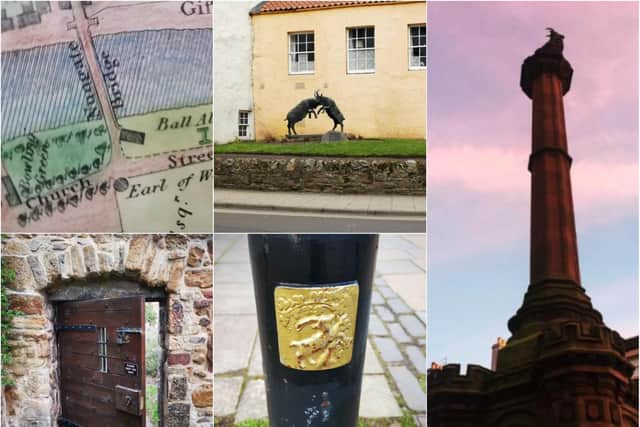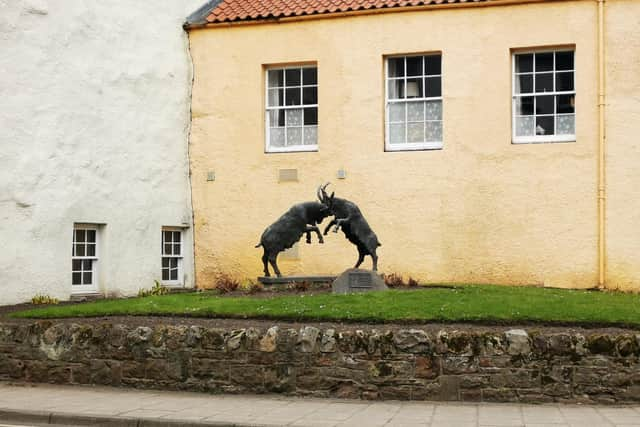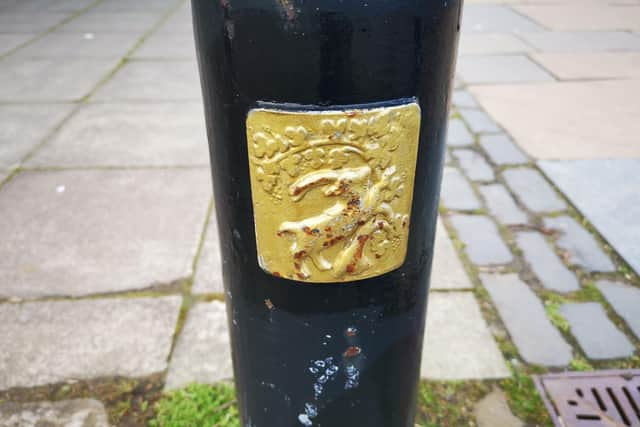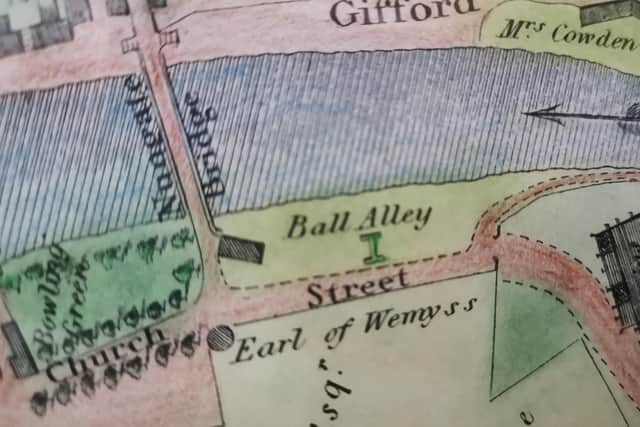Haddington's Goats: Mystery of East Lothian town's historical connection with goats, from feral past to leather, power and unicorns
and live on Freeview channel 276
The River Tyne ambles through this East Lothian market town, sparkling amid the lush fields, forests and hills all around.
Look a little closer, however, and something more unusual starts to present itself: hidden goats.
Advertisement
Hide AdAdvertisement
Hide AdA golden stamp on each bollard on Court Street outside the once bustling Sheriff Court shows an image of the creature.
The local secondary school has the same symbol on its uniform, and a statue of two goats butting heads sits surrounded by brightly blooming flowers at the back of the old George Hotel.
Standing at the centre of the High Street is the Mercat Cross, adorned with the same majestic goat, posing atop a rock and gazing towards the sky.
In Scotland, the Mercat Cross marks a town or city as having the right to hold a market, as granted by the Monarch. It is seen as a symbol of prosperity and authority.


Historical names and literal ones
Advertisement
Hide AdAdvertisement
Hide AdThe question as to why Haddington would have the goat as its symbol is not easy to answer.
When posed the question on a sunny day outside a town centre pub, one resident frowned and mumbled: “I’ve never really thought about it...don’t all towns have a goat?”
Another shrugged: “Yeah, I mean, just got used to seeing all the goats I guess.”


A glance at an old map of the town from 1819 marks a small dwelling, north of the town – which at the time saw miles of farm land stretching into the horizon, but is now near the point where the A1 motorway passes by.
The dwelling marked on the map is called Goatfield.
Advertisement
Hide AdAdvertisement
Hide AdIf you head to that point today, you will find a street sign on a small mews near the spot bearing the same name.
A historical name based on the Haddington symbol? Or a literal one?


Guilds and the penchant for leather
One walking tour of Haddington recommends that eagle eyed explorers watch for the figure of the goat on the west end of Ball Alley.
Where this is may not be clear at first, even to a born and bred Haddingtonian, but usefully, our old map names the grassy area between the Nungate Bridge and St Mary’s Church as Ball Alley.
Advertisement
Hide AdAdvertisement
Hide AdOn the wall of a towering, crumbling Doocot at the north-west end of the alley, there is a plaque which bares a coat of arms.
The plaque itself explains that it marks the nine lime trees that line Ball Alley, planted around 1900 to represent the nine trade guilds of Haddington.


The nine pictures in the crest, which dates from the Middle Ages, represent each of these guilds.
The middle goat, rearing on its hind legs, represents the Skinners – the leather makers.
Advertisement
Hide AdAdvertisement
Hide AdLeatherware company MAHI states that goat leather is not common, with just 9% of our leather from goats as opposed to 65% from cows, 15% from sheep and 11% from pigs.
Given its rarity, surely logic dictates that if the leather makers marked their symbol as a goat, they must have worked predominantly with this animal, no?
It would be astonishing to find out they merely selected a goat for their crest to befuddle their descendants.
A home for goats
What about other explanations – perhaps Haddington was just a place where a lot of goats used to live.
Advertisement
Hide AdAdvertisement
Hide AdWild goats - or feral goats - exist in Scotland and England having been brought here by Neolithic farmers.
These days they are more prominent in the Highlands and their preferred habitats – rich woodlands and vegetated cliffs.
The Wildlife and Countryside Act 1981 considers them to be a non-native species which made it illegal to release goats into the wild.
So yes goats could have existed in the Haddington area, feral or farmed. Or both.
Supplanting the unicorn with a goat
Advertisement
Hide AdAdvertisement
Hide AdThe John Gray Centre, a library, museum and archive for the county, is the next logical step on the goat path.
Though it cannot supply a concrete reason for Haddington's mysterious goat affiliation, it does reveal a marvellous nugget of local history:
“One of the first references to Haddington Market Cross occurs in 1425.
"A pre-Reformation cross existed until 1693 when a notice in the Town Council records indicates that stones had been purchased for "building ane new cross".
Advertisement
Hide AdAdvertisement
Hide Ad"That cross was said to have had a square base with four steps, surmounted by a unicorn.
"In 1811 an Englishman climbed the cross, but in the process pulled over the shaft and broke it into pieces.”
Why they never stuck with this idea of keeping the unicorn we may never fully know, but the broken cross was promptly replaced with a wooden one and, in 1881, the current stone goat was built.
Celtic symbolism
Celtic tribes across Scotland in the Iron Ages were thought to have used symbols from the animal kingdom to differentiate themselves.
Advertisement
Hide AdAdvertisement
Hide AdIf a tribe, living in this pretty little dip in the land, used the goat as their symbol, their identifier, this could have impacted the symbolism in the settlement that eventually appeared and grew.
With Romans, Anglo Saxons and Celts all inhabiting the lands at various points, a combination of myths, legends and ideology mix together to create a rich history.
Over a thousand years of different people, different voices, different cultures joining to form this one, small town.
Perhaps a sighting of an Urisk faerie, a half man, half goat figure from Scottish folklore forever marked the spot as belonging to the goat.
Advertisement
Hide AdAdvertisement
Hide AdPerhaps early settlers saw a goat feeding from a tree, and saw it as a sign of abundance and rich land, and decided to lay claim to the ground.
Or perhaps, this was just a spot where loads of goats used to live.
A message from the Editor:
Thank you for reading this article. We're more reliant on your support than ever as the shift in consumer habits brought about by Coronavirus impacts our advertisers.
If you haven't already, please consider supporting our trusted, fact-checked journalism by taking out a digital subscription.
Comment Guidelines
National World encourages reader discussion on our stories. User feedback, insights and back-and-forth exchanges add a rich layer of context to reporting. Please review our Community Guidelines before commenting.
